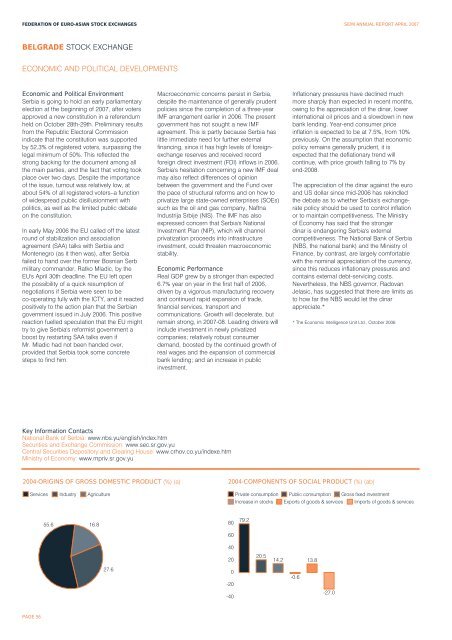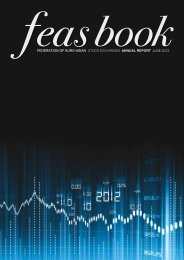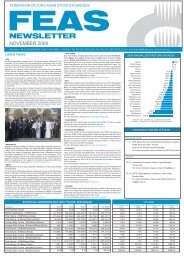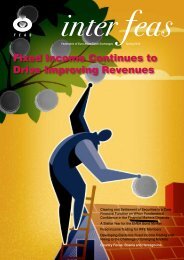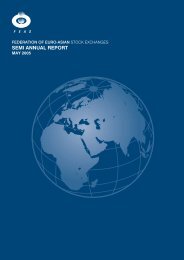Download - FEAS
Download - FEAS
Download - FEAS
You also want an ePaper? Increase the reach of your titles
YUMPU automatically turns print PDFs into web optimized ePapers that Google loves.
FEDERATION OF EURO-ASIAN STOCK EXCHANGES SEMI ANNUAL REPORT APRIL 2007<br />
BELGRADE STOCK EXCHANGE<br />
ECONOMIC AND POLITICAL DEVELOPMENTS<br />
Economic and Political Environment<br />
Serbia is going to hold an early parliamentary<br />
election at the beginning of 2007, after voters<br />
approved a new constitution in a referendum<br />
held on October 28th-29th. Preliminary results<br />
from the Republic Electoral Commission<br />
indicate that the constitution was supported<br />
by 52.3% of registered voters, surpassing the<br />
legal minimum of 50%. This reflected the<br />
strong backing for the document among all<br />
the main parties, and the fact that voting took<br />
place over two days. Despite the importance<br />
of the issue, turnout was relatively low, at<br />
about 54% of all registered voters–a function<br />
of widespread public disillusionment with<br />
politics, as well as the limited public debate<br />
on the constitution.<br />
In early May 2006 the EU called off the latest<br />
round of stabilization and association<br />
agreement (SAA) talks with Serbia and<br />
Montenegro (as it then was), after Serbia<br />
failed to hand over the former Bosnian Serb<br />
military commander, Ratko Mladic, by the<br />
EU's April 30th deadline. The EU left open<br />
the possibility of a quick resumption of<br />
negotiations if Serbia were seen to be<br />
co-operating fully with the ICTY, and it reacted<br />
positively to the action plan that the Serbian<br />
government issued in July 2006. This positive<br />
reaction fuelled speculation that the EU might<br />
try to give Serbia's reformist government a<br />
boost by restarting SAA talks even if<br />
Mr. Mladic had not been handed over,<br />
provided that Serbia took some concrete<br />
steps to find him.<br />
Macroeconomic concerns persist in Serbia,<br />
despite the maintenance of generally prudent<br />
policies since the completion of a three-year<br />
IMF arrangement earlier in 2006. The present<br />
government has not sought a new IMF<br />
agreement. This is partly because Serbia has<br />
little immediate need for further external<br />
financing, since it has high levels of foreignexchange<br />
reserves and received record<br />
foreign direct investment (FDI) inflows in 2006.<br />
Serbia's hesitation concerning a new IMF deal<br />
may also reflect differences of opinion<br />
between the government and the Fund over<br />
the pace of structural reforms and on how to<br />
privatize large state-owned enterprises (SOEs)<br />
such as the oil and gas company, Naftna<br />
Industrija Srbije (NIS). The IMF has also<br />
expressed concern that Serbia's National<br />
Investment Plan (NIP), which will channel<br />
privatization proceeds into infrastructure<br />
investment, could threaten macroeconomic<br />
stability.<br />
Economic Performance<br />
Real GDP grew by a stronger than expected<br />
6.7% year on year in the first half of 2006,<br />
driven by a vigorous manufacturing recovery<br />
and continued rapid expansion of trade,<br />
financial services, transport and<br />
communications. Growth will decelerate, but<br />
remain strong, in 2007-08. Leading drivers will<br />
include investment in newly privatized<br />
companies; relatively robust consumer<br />
demand, boosted by the continued growth of<br />
real wages and the expansion of commercial<br />
bank lending; and an increase in public<br />
investment.<br />
Inflationary pressures have declined much<br />
more sharply than expected in recent months,<br />
owing to the appreciation of the dinar, lower<br />
international oil prices and a slowdown in new<br />
bank lending. Year-end consumer price<br />
inflation is expected to be at 7.5%, from 10%<br />
previously. On the assumption that economic<br />
policy remains generally prudent, it is<br />
expected that the deflationary trend will<br />
continue, with price growth falling to 7% by<br />
end-2008.<br />
The appreciation of the dinar against the euro<br />
and US dollar since mid-2006 has rekindled<br />
the debate as to whether Serbia's exchangerate<br />
policy should be used to control inflation<br />
or to maintain competitiveness. The Ministry<br />
of Economy has said that the stronger<br />
dinar is endangering Serbia's external<br />
competitiveness. The National Bank of Serbia<br />
(NBS, the national bank) and the Ministry of<br />
Finance, by contrast, are largely comfortable<br />
with the nominal appreciation of the currency,<br />
since this reduces inflationary pressures and<br />
contains external debt-servicing costs.<br />
Nevertheless, the NBS governor, Radovan<br />
Jelasic, has suggested that there are limits as<br />
to how far the NBS would let the dinar<br />
appreciate.*<br />
* The Economic Intelligence Unit Ltd., October 2006<br />
Key Information Contacts<br />
National Bank of Serbia: www.nbs.yu/english/index.htm<br />
Securities and Exchange Commission: www.sec.sr.gov.yu<br />
Central Securities Depository and Clearing House: www.crhov.co.yu/indexe.htm<br />
Ministry of Economy: www.mpriv.sr.gov.yu<br />
2004-ORIGINS OF GROSS DOMESTIC PRODUCT (%) (a)<br />
2004-COMPONENTS OF SOCIAL PRODUCT (%) (ab)<br />
Services<br />
Industry<br />
Agriculture<br />
Private consumption Public consumption Gross fixed investment<br />
Increase in stocks Exports of goods & services Imports of goods & services<br />
55.6<br />
16.8<br />
80<br />
79.2<br />
60<br />
40<br />
20<br />
20.5<br />
14.2<br />
13.8<br />
27.6<br />
0<br />
-20<br />
-0.6<br />
-40<br />
-27.0<br />
PAGE 56


